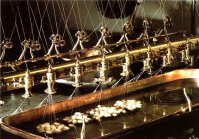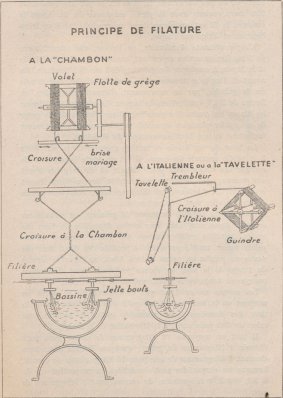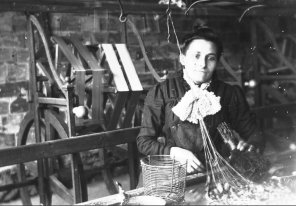- Home
- Resurrection ▾
-
Learn ▾
- Free library
- Glossary
- Documents
- Initiation
-
Shaped fabrics
- Introduction
- Popularization
- Definitions
- Le métier de façonné
- Principes du façonné
- Mécaniques de façonné
- Le jeu des crochets
- Les cartons
- Chaîne des cartons
- Mécanique 104 en détail
- Pour en finir
- Montage façonné
- Empoutage 1/3
- Empoutage 2/3
- Empoutage 3/3
- Punching, hanging and dip
- Autres façonnés
- Façonnés et Islam
-
Cours de tissage 1912
- Bâti d'un métier
- Le rouleau arrière
- Les bascules
- Formation du pas
- Position de organes
- Mécanique 104 Jacquard
- Fonctionnement 104
- Lisage des cartons
- Le battant du métier
- Le régulateur
- Réduction et régulateur
- Mise au métier d'une chaîne
- Mise en route du métier
- Navettes à soie
- Battage
- Ourdissage mécanique
- Préparation chaînes et trames
- Equipment ▾
- Chronicles ▾
- Fabrics ▾
- Techniques ▾
- Culture ▾
- Language ▾
Italian spinning

The cruising is done by two processes, the spinning at the Chambon or at the Italian (or the tavelette).
1/- In the Chambon spinning mill, two threads are formed together, the bundle of wafers which is to form the first thread passes through a die on the left, the one which is to form the second wire passes through a second die on the right. The two beams are twisted with each other for about 200 turns by means of an apparatus called a cruiser or simply with the fingers. It is this twist, which is called by the name of Cruise, which produces the pressure necessary to weld the drool between them. After the crossing, the threads are separated and fixed in fixed barbs placed above the dies and at a certain height, and from there they are brought to a cylinder called asple, aspe, shutter, guindre, which automatically turns, Wraps the silk he draws from the cocoons to form fleets of raw silk. Each wire produces a fleet, consequently with the Chambon spinning mill, two fleets are always obtained. The two sons of rape, after passing over the barbins, are crossed once upon each other. This new crusade takes the name of puzzle-marriage.
2 / - In Italian-style spinning, the criss-cross is made on the wire itself, which allows only one thread to be spun at a time. The bundle of drool, after the exit of the path, ascends a tavern placed at a certain height, descends under a second tavern placed immediately above the sill and a little forward. There, it crosses by a twist of about 200 turns with the rising part of the wire. After the crossing, the thread is held in a hook attached to a trembler and goes to the asple.
In front of the asplet there is a back and forth, which distributes the silk on the guindre, by an alternate and regular movement, in fleets 5 to 7 cm in width.
It takes on average 12 kg of fresh cocoons to obtain 1 kg of raw silk.


The cocoons coming from the threshing are immersed in new basins also containing hot water. The spinner assembles a number of cocoon threads, the number needed to form and a thread of the desired size. The bundle of wires passes through a small porcelain tube immediately above the basin, called a die, and then undergoes a crash or kind of pressure exerted on the bundle to weld the sandstone of all the drool.
Spinning silk
Silk milling involves assembling and twisting the greaves of the cocoons in different ways for each use of the yarn.

The solubility of the sandstone in the hot water enables the cocoons to be drawn, but the thread is so thin that it can not be used for weaving. It is necessary to assemble several cocoon wires to have a sufficient size. The assembly is done when the sandstone is moist. By special pressure, the sandstones of all the united bowls are welded together to form a single wire. The operation takes the name of spinning and the thread obtained that of raw.
But a first preparatory operation called threshing consists in immersing the cocoons in a basin containing hot water (about 60 to 70 degrees centigrade), where they are beaten by means of a heather broom called a squib. Threshing, which is also done by mechanical means, is intended to eliminate the beginning of the cocoon which is spun irregularly by the worm.
Postcard circa 1900. The spinner holds the heather squirrel in his right hand to proceed to the threshing.